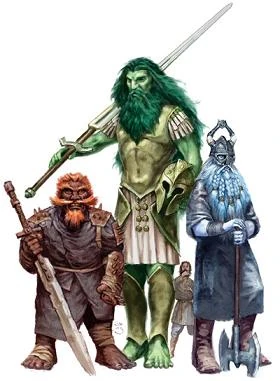Bulette (Geocacharias sp.)
Bulettes are part of family of cingulate mammals, Velocifodiens.
True Giants
Gigans is a genus of hominins with several extant species:
G. horridus (hill giants), G. troglodytes (stone giants), G. gelidus (frost giants), G. igneus (fire giants), G. nubicolus (cloud giants), G. tempestatis (storm giants). Tentative identifications not completely accepted: fog giants (G. nebulosus) and mountain giants (G. rancens)
Goblinoids
Cobalus is the genus of the goblinoids. They may be a separate subtribe (Cobalina) of hominins. Known species include:
C. cobalus (goblins), C. bellatorius (hobgoblins), C. terribilis (bugbears), C. prodigiosus (nilbogs), and C. armatus (norkers)*
*[Thanks to Paul V for this one.]








5 comments:
He's recently opened up "All Dead Generations" https://alldeadgenerations.blogspot.com/
I love fantasy naturalist stuff like this. Embracing it leads to all sorts of nature-documentary weirdness.
Personally I'm conflicted. On one hand I find your latin names and taxonomy charming and funny ... but on the other hand I have this angst about Positivist fantasy settings. Linnaean taxonomy is thoroughly rooted in the Enlightenment and refined well into Modernity. It would work neatly for a setting of a similar sort of epoch but in much 'D&D Fantasy' there's this tendency to ignore the weird beauty of the Medieval mind (e.g. the philosophically based Aristotelian taxonomy - which leads ultimately to Borges' fictional "Chinese Encyclopedia") in favor of a faux modernity. To my mind it's the sort of thing that leads to players trying to sell "Continual Light Lamps" and Magic Carpet air taxi services. I find this sort of thing painful - like the way every Inn in a setting is an 18th century English Coaching Inn. I am likely thinking about this too much.
@Gus - I understand. I have a few thoughts: I like Medieval, pre-Enlightenment stuff as much as the next guy, but I don't really see that stuff actually leveraged in games all that often. The Great Wheel cosmology is the most Ptolemaic thing Gygax ever did and people can't wait to jettison it for "planes as planets." Then, of course, modern thought pervades the way people interact with the game in all sorts of ways. I do think you can have fantasy walk hand in hand with more modern mindsets (this is what I tried to do with Weird Adventures, and think I succeeded at), but I think you have to work to make the world fantastic. Most D&D settings, despite their strict adhere to pre-modern trappings are in sensibility more like TV Westerns with swords.
The other thing is, I don't necessarily intend that this nomenclature be used in-game in every setting or really even any setting. This was sort of done at a fictional remove: people from our world or something similar cataloging a D&D world.
LOL @ 'Dungeons of Sighs' - perhaps this contains natural acoustic properties and an air element with sleep apnea?
Post a Comment